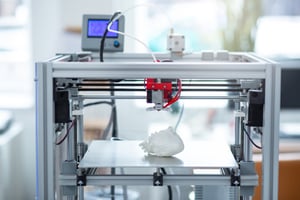In this special blog series, we will review the disruptive technologies being introducing by today’s forward-thinking manufacturers. Over the next few weeks, you’ll learn about the cutting-edge tools transforming the industry and the ways ERP can support their implementation.
Initially, you might consider 3D printing to be a threat to manufacturers. After all, in the hands of consumers, a 3D printer can make any individual an amateur manufacturer, or “maker.” But in the hands of an expert manufacturing company, 3D printing is introducing new levels of efficiency – for both time and materials – while fostering innovation in R&D. Here’s how forward-thinking manufacturers are leveraging 3D printing to their advantage.
“Additive” Manufacturing
In many industries, scrap is a necessary part of the manufacturing process. Raw materials are used to produce a given product and once cut and shaped,  the remaining materials are either discarded or, in the case of materials like sheet metal in automobile manufacturing, can be reprocessed.
the remaining materials are either discarded or, in the case of materials like sheet metal in automobile manufacturing, can be reprocessed.
Today, through the use of industrial 3D printers available from companies like MarkForged and Desktop Metal, a given design – everything from spare machine parts to entire housing communities – can be executed with little to no leftover materials. With a CAD file in hand, a 3D printer adds layer upon layer of sheet material, liquid, powder or other materials to fabricate a 3D object. This precise, iterative process – sometimes referred to as “additive manufacturing” – reduces material waste, production time and the need for additional equipment.
The Benefits of 3D Printing
Adding a 3D printer to the factory floor can run between $5,000 and $500,000; however, savvy manufacturers are seeing their return on investment play out in several areas.
On the production line, parts can be created and made-to-order customization is accommodated through the use of 3D printing. 3D printing also facilitates smaller production runs that may prove more cost-effective when 3D printed. In the R&D department, prototypes can be 3D printed rather than handcrafted or made from molds, removing some of the barriers and start-up costs of product innovation. This allows manufacturers to be more experimental and less concerned with the costs involved in trial and error.
Altogether, 3D-printed products often require less time and money – as well as energy, contributing less carbon emissions to the environment – than traditional manufacturing processes.
Conclusion
The benefits of 3D printing are clear, but to integrate such a modern technology into your production methods, it will also need to be integrated into the IT environment – including your ERP system.
For example, when 3D printing parts, intellectual property is an important part of the equation. As such, your ERP system must be equipped to store IP-related documentation. For example, your material master record (MMR) must designate which parts you have the rights to print, and a distinct record for the printed version may be required. The bill of materials (BOM) should identify the raw materials and quantities, and master data should include the IP and licenses required for the parts at hand.
Modern ERP solutions equipped with predictive analysis can also assist in decision-making related to 3D printing. With these advanced functions, an ERP system can look at your inventories and the cost of procurement and deliver business insights to help determine if 3D printing would be a cost-effective solution to fulfill demand in a given scenario.
3D printing has the potential to save manufacturers time and money, but realizing this value requires more than just the right equipment. With the support of a tried-and-true ERP system, your business will have the intel needed to determine when opportunity strikes and how best to seize it with your 3D printing capabilities.
Curious about other tech trends in Manufacturing?
Download our e-book, “Disruptive Manufacturing: 3 Technologies That Will Transform You Operations,” to learn about leading-edge technologies and features emerging in the world of ERP.
Choosing an ERP Consultant
One-size-fits-all is not an option when it comes to ERP systems. The Copley Consulting Group knows there are several factors to determine the right fit for your organization. When working to implement your ERP solution, Copley can provide the technology and support needed for your specific industry and business when choosing between cloud-based or an on-premise ERP. To discuss the right ERP system for your organization, complete our contact form, call us at 855-884-5305, or email us at info@copleycg.com.

